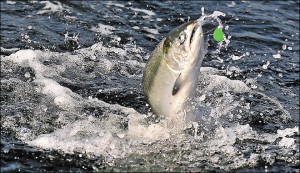
MEDFORD, Ore. (AP) — Enough adult salmon are now finning off the Southern Oregon and Northern California coasts to give Brookings a good chance to repeat as Oregon’s top port for boating chinook.
But the ever-changing ocean currents have to do their part.
 Preseason estimates of chinook and fin-clipped coho salmon in the ocean are high enough that salmon anglers are on the cusp of seeing a summer saltwater salmon season nearly identical to 2014, when Brookings regained its spot as the top chinook port after a one-year hiatus.
Preseason estimates of chinook and fin-clipped coho salmon in the ocean are high enough that salmon anglers are on the cusp of seeing a summer saltwater salmon season nearly identical to 2014, when Brookings regained its spot as the top chinook port after a one-year hiatus.
But El Nino currents forming in the Pacific threaten to disrupt the cold-water patterns needed near shore to draw in the bait fish that in turn draw chinook and coho into the reach of Oregon’s bustling offshore recreation fleet.
“The season, of course, depends upon how the ocean sets up,” says Richard Heap, a Brookings angler who represents Oregon anglers in federal salmon-season discussions. “If it does, the fish should be there. Hopefully, we’ll knock the stuffing out of them and everybody will be happy.”
And everybody may have to rely on this summer’s good feelings for a while.
The class of chinook that headed to sea as smolts in 2013 are so far showing poor returns, which has Heap and others bracing for reduced fishing days next year, when that brood year of chinook dominates the catches and determines how the seasons will be crafted.
“I guess people are holding their breaths,” Heap says. “This could be the last good year for a while.”
Just when this year’s ocean season begins and potentially how good it becomes will be known April 10, when federal salmon managers set the seasons.
The Pacific Fishery Management Council is mulling three options for the 2015 seasons that each have chinook season opening off Southern Oregon in May and running through Sept. 7, the latest potential Labor Day possible.
The options range from opening May 1, as it did last year, May 9 or as late as May 27. The May portion of the schedule probably isn’t a huge deal on the south coast, because the waters off Brookings don’t normally teem with chinook until summer, when chinook migrate north past California to reach Oregon’s open waters.
The fin-clipped coho season off most of Oregon is proposed to start either June 27 or July 1, with a quota ranging from a high of 60,000 to a low of 40,000. The likely quota is slightly more than 50,000 fin-clipped coho, which is more than the Oregon fleet landed all of last season.
The PFMC is scheduled to finalize the seasons off Washington, Oregon and California when it concludes its annual salmon meeting April 10 in Sacramento.
“Obviously, we’re not down to the final bell, so it’s always hard to say what’s going to come out,” says Eric Schindler, the ocean sampling project leader for the Oregon Department of Fish and Wildlife. “But on the (recreation) side, I think we’ll be coming out well.”
While the availability of fin-clipped coho can turn an occasional bad day into a busy one on the ocean, coho are largely an afterthought out of Brookings.
“That’s not our bread and butter,” Heap says. “It’s chinook.”
And no Oregon coastal port buttered its bread better in 2014 than Brookings, whose south-facing bar is relatively sheltered from northwest winds, which makes it a favorite among recreational boaters.
Last year Brookings anglers landed 6,802 chinook, which is more than one-third of the entire Oregon ocean catch from Astoria to the California border. It reclaimed its No. 1 status from Winchester Bay, which in 2013 edged Brookings in landings largely because the season there opens in mid-March and runs through October.
Gold Beach, which is often hampered by a rough bar but buoyed by a vibrant bay fishery, saw just 15 ocean-caught chinook landed there last year, down from 21 in 2013.
Chinook seasons off Southern Oregon and Northern California live and die based on the relative health of adult salmon bound for California’s Klamath and Sacramento rivers. So far, those that will dominate the adult catch next year have not shown good abundance, meaning this year’s season could be talked about as a remember-when summer.

Recent Comments